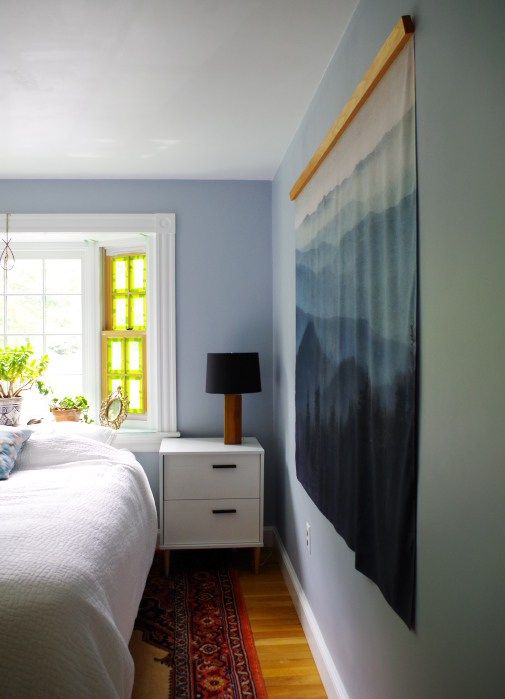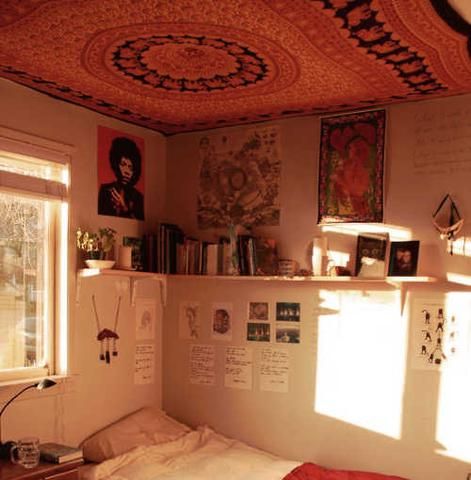? Please, support Serhii’s & Viktoria’s blog. Share it on Facebook or Pin it on Pinterest. Your support inspires more great content! ?
The Ultimate Guide How to Hang Tapestry: 7 Ways. Are you looking to add a touch of bohemian flair to your space? Hanging a tapestry is the perfect way to infuse color and texture into your home decor. But figuring out the best way to hang a tapestry can be a bit of a challenge. That’s why we’ve put together the ultimate guide on how to hang tapestry, with 7 different methods to choose from.

In this comprehensive guide, we’ll walk you through every step of the process, from selecting the right tapestry for your space to hanging it securely and seamlessly. Whether you’re a seasoned interior design pro or a beginner looking to spruce up your living room, our guide will help you achieve the perfect tapestry display.
We’ll cover everything from traditional methods like using a curtain rod or nails, to more creative options like using clips or command strips. Plus, we’ll provide tips and tricks to ensure that your tapestry hangs straight and stays in place.
So if you’re ready to transform your space with a stunning tapestry display, keep reading to discover the ultimate guide on how to hang tapestry.
- Benefits of using tapestries as wall decor
- Different types of tapestries
- Choosing the right tapestry for your space
- Preparation before hanging a tapestry
- 7 creative ways to hang a tapestry
- YouTube Video: How to Hang a Tapestry in 3 Easy Ways
- Step-by-step guide for each hanging method
- YouTube Video: Wall Tapestry 5 Ways
- Tips for maintaining and cleaning tapestries
- Frequently asked questions about hanging tapestries
- Conclusion: Enhance your space with a beautiful tapestry
Benefits of using tapestries as wall decor
Tapestries have been used as wall decor for centuries, and for good reason. They offer a unique way to add color, pattern, and texture to any space. Unlike traditional artwork, tapestries are versatile and can be easily changed or moved around to suit your decor needs. They also have the added benefit of providing insulation and sound absorption, making them a practical choice for both aesthetic and functional purposes.

In addition to their visual appeal, tapestries can also tell a story or convey a particular theme. From intricate historical scenes to abstract designs, there is a tapestry out there for every taste and style. Whether you’re looking to create a cozy reading nook or a statement wall in your living room, a tapestry can help you achieve the desired effect.
Different types of tapestries
Before you start hanging a tapestry, it’s important to understand the different types available. Tapestries come in a variety of materials, including cotton, wool, silk, and synthetic fibers. Each material has its own unique characteristics and can affect the overall look and feel of the tapestry.
Cotton tapestries are lightweight and easy to clean, making them a popular choice for everyday use. They are also more affordable compared to other materials, making them a great option for those on a budget. Wool tapestries, on the other hand, are known for their warmth and durability. They have a luxurious feel and are often used in more formal or traditional settings.

Silk tapestries are prized for their lustrous appearance and delicate texture. They add a touch of elegance to any space, but they require more care and maintenance compared to other materials. Synthetic fiber tapestries, such as polyester or acrylic, are a more affordable alternative to natural fibers. They offer a wide range of designs and colors, and they are typically easier to clean and maintain.
Choosing the right tapestry for your space
When selecting a tapestry for your space, there are a few factors to consider. First, think about the overall style and color scheme of your room. Do you want the tapestry to be a focal point or blend in with the rest of your decor? Consider the size of the tapestry as well, taking into account the dimensions of your wall and the surrounding furniture.
It’s also important to consider the theme or design of the tapestry. Are you looking for something abstract, floral, or historical? Think about the mood or atmosphere you want to create in your space. For example, a nature-inspired tapestry can bring a sense of tranquility and serenity, while a bold and vibrant design can add energy and excitement.
Preparation before hanging a tapestry
Before you start hanging your tapestry, it’s important to prepare the wall and the tapestry itself. Start by cleaning the wall surface to ensure that it’s free from dust and debris. This will help the tapestry adhere properly and prevent any damage to the wall.

Next, inspect the tapestry for any loose threads or frayed edges. If you notice any, carefully trim them with a pair of scissors to prevent further unraveling. If your tapestry is wrinkled or creased, you can gently steam it or iron it on a low heat setting to remove the wrinkles.
7 creative ways to hang a tapestry
Now that you’re ready to hang your tapestry, let’s explore 7 different methods to choose from. Each method offers a unique way to display your tapestry and can be adjusted to suit your specific needs and preferences.
1. Using a curtain rod: This is one of the most common methods for hanging a tapestry. Simply attach a curtain rod to the wall and slide the tapestry onto the rod. This method allows you to easily swap out the tapestry whenever you want to change up your decor.

2. Using nails or hooks: If you prefer a more permanent solution, you can use nails or hooks to secure your tapestry to the wall. Make sure to choose the right size and weight capacity for your tapestry, and carefully measure and mark the desired placement before hammering in the nails or hooks.

Click to purchase this product on Amazon – Transparent Reusable Waterproof Sticky Seamless Hooks
3. Using clips or clothespins: For a more casual and effortless look, you can use clips or clothespins to hang your tapestry. Simply attach the clips or clothespins to the top edge of the tapestry and then hang them onto a string or wire that is secured to the wall.

Click to purchase this product on Amazon – Clothespins
4. Using a tension rod: This method is ideal for those who don’t want to make any holes in the wall. A tension rod can be placed between two walls or inside a doorway, and the tapestry can be hung from the rod using clips or rings.

Click to purchase this product on Amazon – Tension rods
5. Using command strips: Command strips are a great option for renters or those who don’t want to damage their walls. Simply attach the command strips to the back of the tapestry and then press it firmly onto the wall. Make sure to follow the instructions on the packaging for best results.

Click to purchase this product on Amazon – Command strips
6. Using a decorative ladder: If you’re looking for a more unique and decorative way to display your tapestry, consider using a decorative ladder. Lean the ladder against the wall and drape the tapestry over the rungs. This method adds a touch of rustic charm to any space.

Click to purchase this product on Amazon – Decorative ladder
7. Using a curtain wire: Similar to a tension rod, a curtain wire can be easily installed between two walls. Attach the wire to the walls using hooks or screws, and then hang the tapestry from the wire using clips or rings. This method allows you to easily adjust the height and position of the tapestry.
YouTube Video: How to Hang a Tapestry in 3 Easy Ways
Step-by-step guide for each hanging method
Now that you know the different methods for hanging a tapestry, let’s dive into a step-by-step guide for each method. Follow these instructions to ensure that your tapestry hangs securely and looks seamless.
1. Using a curtain rod:
– Measure the width of your tapestry and choose a curtain rod that is slightly larger.
– Install the curtain rod on the wall, following the manufacturer’s instructions.
– Slide the tapestry onto the curtain rod, making sure that it is centered and straight.
– Adjust the height of the curtain rod to achieve the desired placement of the tapestry.
2. Using nails or hooks:
– Measure and mark the desired placement of the tapestry on the wall.
– Choose the right size and weight capacity for your nails or hooks.
– Hammer the nails or screw in the hooks at the marked spots.
– Carefully hang the tapestry on the nails or hooks, ensuring that it is level and straight.
3. Using clips or clothespins:
– Attach the clips or clothespins to the top edge of the tapestry.
– Secure a string or wire to the wall, making sure it is taut and level.
– Hang the tapestry onto the string or wire, adjusting the position as needed.
4. Using a tension rod:
– Measure the width of the space where you want to hang the tapestry.
– Choose a tension rod that fits snugly between the walls or inside the doorway.
– Adjust the tension rod to the desired width, making sure it is secure.
– Attach clips or rings to the top edge of the tapestry and hang it from the tension rod.
5. Using command strips:
– Clean the wall surface with rubbing alcohol and let it dry.
– Attach the command strips to the back of the tapestry, following the instructions on the packaging.
– Remove the protective liner from the command strips and press the tapestry firmly onto the wall.
– Hold the tapestry in place for a few seconds to ensure a strong bond.
6. Using a decorative ladder:
– Lean the decorative ladder against the wall, making sure it is stable.
– Drape the tapestry over the rungs of the ladder, adjusting the position as needed.
– Secure the tapestry to the ladder using clips or clothespins, if desired.
7. Using a curtain wire:
– Measure the distance between the two walls where you want to hang the tapestry.
– Install hooks or screws on both walls, following the manufacturer’s instructions.
– Attach the curtain wire to the hooks or screws, making sure it is taut and level.
– Hang the tapestry from the wire using clips or rings, adjusting the height and position as needed.
YouTube Video: Wall Tapestry 5 Ways
Tips for maintaining and cleaning tapestries
To keep your tapestry looking its best, it’s important to follow a few maintenance and cleaning tips. First, avoid placing your tapestry in direct sunlight, as prolonged exposure can cause fading and damage to the fibers. If your tapestry does get dirty, gently vacuum it using a soft brush attachment or shake it outdoors to remove any loose dirt or dust.
For more stubborn stains or spills, spot clean the affected area using a mild detergent and cold water. Avoid rubbing or scrubbing the tapestry, as this can cause the colors to bleed or the fibers to become damaged. Instead, gently blot the stain with a clean cloth or sponge.
If your tapestry requires a deeper clean, consider professional dry cleaning. Be sure to follow the care instructions provided by the manufacturer, as some tapestries may not be suitable for dry cleaning.

Frequently asked questions about hanging tapestries
1. Can I hang a tapestry on a textured wall? Yes, you can hang a tapestry on a textured wall. However, it may require additional support, such as using adhesive hooks or nails that are suitable for textured surfaces.
2. What should I do if my tapestry is too long for the wall? If your tapestry is too long for the wall, you can fold or gather the excess fabric at the bottom and secure it with clips or clothespins. This can create a draped effect and add visual interest to the display.
3. How do I prevent my tapestry from sagging or drooping? To prevent your tapestry from sagging or drooping, make sure it is securely fastened to the wall. Use additional clips or clothespins along the sides or bottom of the tapestry to keep it taut and in place.
4. Can I hang multiple tapestries together? Yes, you can hang multiple tapestries together to create a layered or gallery wall effect. Experiment with different sizes, colors, and patterns to achieve a unique and personalized display.
Conclusion: Enhance your space with a beautiful tapestry
In conclusion, hanging a tapestry is a great way to add style and personality to your space. With the 7 different methods provided in this guide, you can easily find a hanging solution that suits your needs and preferences.
Remember to choose the right tapestry for your space, prepare the wall and the tapestry before hanging, and follow the step-by-step instructions for each hanging method. And don’t forget to maintain and clean your tapestry regularly to keep it looking its best.
So go ahead and transform your space with a beautiful tapestry display. Whether you’re looking to create a cozy reading nook, a statement wall, or a bohemian-inspired bedroom, a tapestry can be the perfect finishing touch. Happy hanging!







